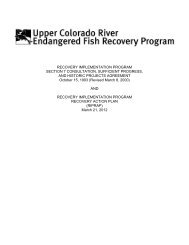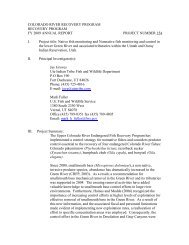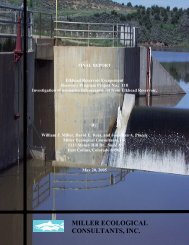K. R. Bestgen, K. A. Zelasko, and G. C. White. Monitoring ...
K. R. Bestgen, K. A. Zelasko, and G. C. White. Monitoring ...
K. R. Bestgen, K. A. Zelasko, and G. C. White. Monitoring ...
Create successful ePaper yourself
Turn your PDF publications into a flip-book with our unique Google optimized e-Paper software.
eproduction is observed <strong>and</strong> when larvae are more abundant. Nevertheless, findings will be<br />
useful to evaluate population status <strong>and</strong> response to management actions, including flow<br />
management. We suggest additional sampling <strong>and</strong> research to better underst<strong>and</strong> fish distribution<br />
<strong>and</strong> entrainment into floodplain wetl<strong>and</strong>s, capture efficiency, <strong>and</strong> genetic verification of<br />
identified larvae.<br />
Valuable capture-recapture data for large juvenile <strong>and</strong> adult razorback suckers in the<br />
Green <strong>and</strong> Colorado River systems is available from existing sampling programs, particularly<br />
that for Colorado pikeminnow Ptychocheilus lucius. That sampling occurs on a three-year on,<br />
two-year off cycle <strong>and</strong> will form the foundation for monitoring larger-bodied razorback suckers.<br />
However, that sampling by itself is insufficient to effectively monitor survival <strong>and</strong> population<br />
abundance of large juvenile <strong>and</strong> adult razorback suckers <strong>and</strong> additional sampling <strong>and</strong> recaptures<br />
of tagged fish are needed in those years to increase recapture rates. We analyzed habitat types of<br />
captures made in spring in each system, <strong>and</strong> additional sampling should minimally focus on<br />
slackwater channel margin habitat including flooded tributary mouths, backwaters, <strong>and</strong> eddies in<br />
each system. Additional active sampling (e.g., electrofishing) as well as passive sampling (e.g.,<br />
fyke/trap nets) is proposed. <strong>Monitoring</strong> of concentration areas, especially those near spawning<br />
areas, via PIT tag detector arrays would be especially useful because those may maximize<br />
captures when fish are concentrated <strong>and</strong> reduce potential h<strong>and</strong>ling effects <strong>and</strong> disturbance. A<br />
last resort would be more active sampling directly over spawning areas, an option which should<br />
be explored only if other techniques do not yield sufficient recapture information. Additional<br />
sampling effort should overlap sampling for Colorado pikeminnow closely in time <strong>and</strong> space so<br />
that it can be incorporated into abundance estimation data; data useful for estimation of survival<br />
estimates can be collected over a broader time frame <strong>and</strong> is not as restrictive as that for<br />
abundance estimates. Simulations were also conducted to guide the minimum levels of sampling<br />
needed to raise probabilities of capture to 1) reduce bias of parameters derived from recapture<br />
data, <strong>and</strong> 2) increase precision to levels that provide useful estimates. We also make<br />
recommendations for frequency <strong>and</strong> type of data analyses to make best use of data gathered in<br />
the future. Implementation of this monitoring program should increase the ability of managers to<br />
make informed decisions regarding the status of razorback suckers in the Green <strong>and</strong> Colorado<br />
River systems, which should assist in evaluation of conservation <strong>and</strong> recovery status of the<br />
species.<br />
4










